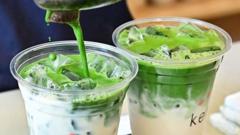The explosive popularity of matcha, a finely ground green tea with its roots in Japan, has led to a severe contraction in global supply, sending prices soaring. The trend has been exacerbated by heatwaves affecting crop yields, coupled with stringent U.S. tariffs on Japanese imports right at a time when demand is fueled by the tourism boom stemming from Japan's weakened currency.
Social media platforms, particularly TikTok, have played a pivotal role in this frenzy, with hashtags like "Matcha Tok" garnering millions of views as influencers showcase brewing techniques and creative recipes. Lauren Purvis, a U.S.-based importer, noted how customers previously used to buying a month's worth of matcha now find their supplies running out within days. Some cafes report needing up to a kilogram daily just to keep up.
Matcha, known for its rich umami flavor and health benefits, is generated through a meticulous production process where tencha leaves are shaded, harvested, dried, and stone-ground. However, the recent unprecedented heat waves, particularly in Kyoto—responsible for a substantial proportion of Japan's matcha crop—have resulted in devastating yields. Compounded by an aging farming population with few young entrants, accessibility to high-quality matcha is increasingly restricted.
Local shops in traditional matcha heartlands like Uji have implemented purchasing limits as visitors quickly empty shelves. For instance, in a popular tea establishment within Kyoto, customers are restricted to purchasing only one tin of matcha at a time. As stocks dwindle and lead times stretch, establishments like Chazen have witnessed around a 30% surge in tea prices this year.
Despite the rising prices, the matcha market is burgeoning, with production significantly increasing over the past decade and exports surging as well. The Global Japanese Tea Association has called for a movement towards mindful consumption, urging tea enthusiasts to treat matcha with respect and avoid hoarding or misusing it in cooking, where its delicate flavors can be lost.
Alongside rising prices, the looming 15% import tariffs imposed by the U.S. threaten further complications. With tea exports not jeopardizing any local industry, many importers advocate for exceptions to these tariffs to protect specialty tea like matcha.
While current demand seems overwhelming, some in the industry anticipate a moderation in price and interest over the next few years. As the market stabilizes, a balance between supply and demand will hopefully allow for fair access to matcha without jeopardizing its cultural significance.
Amidst a complex web of climate impacts and consumer behavior, stakeholders are left navigating the fluctuations in the matcha trade, hoping for a return to both abundance and appreciation for this treasured tea.
Social media platforms, particularly TikTok, have played a pivotal role in this frenzy, with hashtags like "Matcha Tok" garnering millions of views as influencers showcase brewing techniques and creative recipes. Lauren Purvis, a U.S.-based importer, noted how customers previously used to buying a month's worth of matcha now find their supplies running out within days. Some cafes report needing up to a kilogram daily just to keep up.
Matcha, known for its rich umami flavor and health benefits, is generated through a meticulous production process where tencha leaves are shaded, harvested, dried, and stone-ground. However, the recent unprecedented heat waves, particularly in Kyoto—responsible for a substantial proportion of Japan's matcha crop—have resulted in devastating yields. Compounded by an aging farming population with few young entrants, accessibility to high-quality matcha is increasingly restricted.
Local shops in traditional matcha heartlands like Uji have implemented purchasing limits as visitors quickly empty shelves. For instance, in a popular tea establishment within Kyoto, customers are restricted to purchasing only one tin of matcha at a time. As stocks dwindle and lead times stretch, establishments like Chazen have witnessed around a 30% surge in tea prices this year.
Despite the rising prices, the matcha market is burgeoning, with production significantly increasing over the past decade and exports surging as well. The Global Japanese Tea Association has called for a movement towards mindful consumption, urging tea enthusiasts to treat matcha with respect and avoid hoarding or misusing it in cooking, where its delicate flavors can be lost.
Alongside rising prices, the looming 15% import tariffs imposed by the U.S. threaten further complications. With tea exports not jeopardizing any local industry, many importers advocate for exceptions to these tariffs to protect specialty tea like matcha.
While current demand seems overwhelming, some in the industry anticipate a moderation in price and interest over the next few years. As the market stabilizes, a balance between supply and demand will hopefully allow for fair access to matcha without jeopardizing its cultural significance.
Amidst a complex web of climate impacts and consumer behavior, stakeholders are left navigating the fluctuations in the matcha trade, hoping for a return to both abundance and appreciation for this treasured tea.



















